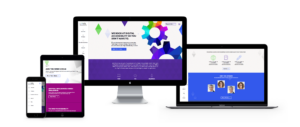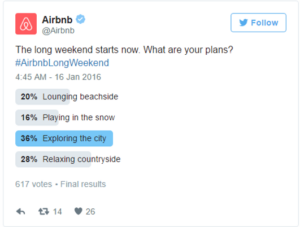As the world has changed in the blink of an eye, so has the way we market to consumers. Now, more than ever, your website exists as BY FAR THE MOST IMPORTANT doorway to your brand and your brand experience. While stores stay shut, and face-to-face interaction is vastly limited, brands will rely on reaching their target audiences via their websites. Therefore, your website is mission-critical to your success.
Bluetext has published a 5 part blog series to help you think about and pressure test if your website is the best it can be.
With 57% of the world’s population now on the internet, promoting your business through a website has become even more critical. Additionally, over 50% of website traffic comes from mobile, and over 66 million American adults now own a smart speaker with digital assistant capabilities. Your website is where a potential customer will get their first impression of your business, and navigating the way website browsing behavior continuously evolves can be tricky. Because having a poorly designed website can be worse for your business than having no website at all, turning toward an expert website design agency can help you find the best website solution for your company. An agency can help you stay on top of the latest web design trends, and bring both your website and your business to the next level.
User experience (UX) is one of the most important things to consider when redesigning your new website. According to Jakob’s law, users spend most of their time on websites other than yours. This means that users prefer for your site to function in a similar manner to other sites they frequently interact with. Staying up-to-date with current web design trends is imperative to keep your users engaged.
Bluetext suggests considering the following seven trends when building your website to ensure that your site combines SEO functionality with the best UX, boosting your brand’s presence online.
1. Make Mobile a Priority
Over 50% of all website traffic comes from mobile. With a user-base continuously becoming more dependent on mobile, it is even more important for website designers to prioritize and optimize web experience for mobile devices. Designers must create a thumb-friendly design to not only make mobile navigation easier for the user but also create a seamless, visually-appealing design.
More than 60% of companies reported an increase in sales after designing mobile responsive platforms; however, approximately 40% of people will leave your website if it isn’t mobile-friendly. While simply having a mobile presence may seem good enough, optimizing this experience through design to cater to mobile users is the most important factor.
If these statistics aren’t convincing enough, it’s also important to keep in mind that Google gives priority to mobile-friendly sites by ranking them higher in search results, positively impacting your SEO. Lacking a mobile-friendly experience can negatively impact your website’s ranking, whereas sites that are mobile responsive will often receive a ranking boost, even for searches on a desktop.
Check out some of Bluetext’s work on mobile with Paya and Mindtree.
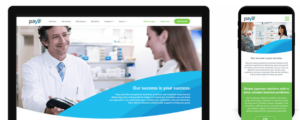
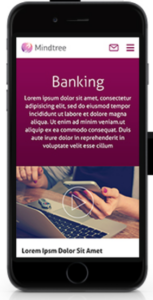
2. Increase Page Speed
It takes users only three seconds to decide whether or not they want to stay on your website. These three seconds are crucial to your website’s dwell time (aka the time a user spends on your website before returning to the search results). Web design agencies can provide creative solutions to help engage your users within these three seconds. Additionally, web agencies know the best tactics for improving page speed, such as image compression. Image formats like JPEG 2000, JPEG XR, and WebP often provide better compression than PNG or JPEG, which means faster downloads and less data consumption.
The less time it takes your website to load, the better your SEO. Because of the Google Speed Update, Google won’t prioritize your website to users if it will take too long to load. Taking your site to a web design agency will ensure that your website is optimized for the user, while also ensuring that you have the best possible SEO ranking.
3. Optimize for Voice Search
Page speed is also becoming more important as the number of smart speakers and digital assistants continues to grow. Over 66 million American adults now have a smart speaker, and designing a website that capitalizes on Voice Search Optimization is the only way to ensure that those using smart devices for their searches will have access to your site. Voice search is meant to be a faster, more convenient way to get information, and if your website takes too long to load, it is less likely to be returned for a voice search result.
According to a PWC study, 71% of respondents would rather use their voice assistant to search for something than manually typing their query into a search engine. The differences between these spoken and typed searches may lead to different SERP results, and if your website is not properly optimized for vocal search, you may lose ground to your competitors. Because vocal searches only result in one top result, everyone is vying for this “ground zero” position. You can obtain this coveted position by gaining Google’s featured snippet spot, which aims to directly answer users’ questions. Voice searchers are also more likely to search in long-form questions as opposed to using shorter keywords, so it’s important to consider the types of questions your target audience may ask, and to position your website well to answer these searches.
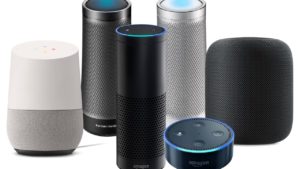
4. SEO vs. SEM: Choose Wisely
How can you tell whether to focus your marketing efforts on SEO or SEM? Let’s return to square one: what’s the difference? Search Engine Optimization (SEO) was traditionally thought of as a component of Search Engine Marketing (SEM), which comprised of both paid and organic tactics. However, this language is shifting, with SEM now referring exclusively to paid search. SEO is a method to optimize your website to receive organic traffic, while SEM is a way to funnel in relevant traffic from search engines by buying paid or sponsored ad listings.
So which is better to focus on for your website? SEO allows your business to get more visibility, building brand awareness at a low cost. Choosing keywords that are relevant to your website can earn you a spot on the first page of the SERPs, automatically earning you credibility and trust from search users. In order to increase your website’s chances of making this first page, follow these simple steps:
- Use relevant keywords in the URL to describe the content of the page
- Use your main keywords in the beginning of the title tag of your page
- Use the right keywords in the meta description of your page and make sure it is enticing enough for users to click-through to your site
- Use your primary keyword(s) in the H1 tag of your page
- Use your main keywords along with related long-tail keywords in the first few paragraphs of the page
SEO will bring your website brand visibility at a lower cost, but it’s important to invest in researching which keywords will best optimize your website.
While SEO is typically more sustainable, turning to SEM can also do wonders for your website. SEM allows you to capture the attention of your target audience by claiming a spot above-the-fold of the SERPs. Sponsored listings also give you more control over the results you achieve; every element of the ad can be customized and tweaked to target your audience. SEM charges on a per-click basis, and while this may be more expensive, it allows you to achieve quick, measurable results without going through the trial-and-error process that SEO typically involves.
Both SEO and SEM have their pros and cons, and both may be right for your business at different times. Turning to an agency that specializes in SEO and SEM will help you choose the right tactic at every turn.
5. Hello, Homogenous Hero
The fast pace of modern life means that people have less time to spend on your website. When they enter your site, simple and intuitive web design will allow them to quickly find what they’re looking for. The use of minimal design allows for the rapid digestion of information and ultimately leads to more satisfied users.
The inability to spend endless time searching for information on a website also means that many web design agencies are moving away from the once-popular ubiquitous site, and shifting instead toward the homogenous hero. Instead of boldly featuring the headline in the center of the landing page, designers are opting instead to move the header and CTA to one side, with the image on the opposing side. This split-screen aesthetic also allows for easy conversion to mobile, providing a clear dividing line between the two content blocks.
Check out some of Bluetext’s latest homogenous hero designs through their work with Centauri and Perspecta.
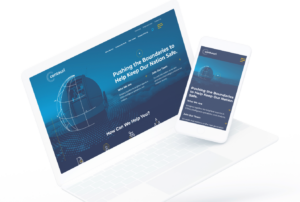

6. Animate Your Site
The use of animation is an easy way to make your website appear polished and dynamic. Animation also helps bring your brand’s story to life, quickly engaging users and drawing more visitors to your homepage. When used as a tool to communicate complex messages easily, animation can reduce the time that a user must spend in order to understand your message, which enables them to spend more time exploring your website.
When adding animation and motion into your website design, it is important to consider web image optimization, which is the process of providing the smallest-sized images optimized in terms of quality, resolution, and format. With the rise of internet browsing on mobile, images and animations must be optimized to perform well on mobile. While animations are a fantastic way to engage your site visitors, they can also slow down your website load times and negatively impact your SEO. Let a professional website design agency like Bluetext help ensure that your website can support lively animation without dragging down your website load time.
When Bluetext redesigned the Clarabridge website, we made sure to incorporate motion in a sophisticated way, making the UX come alive. We used motion throughout the homepage to engage the user and pull them further down the landing page. This design also quickly explains how Clarabridge works and allows a site visitor to visualize how they might best use Clarabridge’s services.
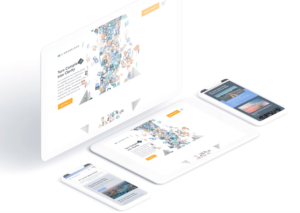
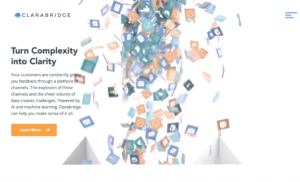
7. Incorporate More Video Content
Video content diversifies your web page, and also appeals to those fast-moving users who do not have the time to search through a lot of text. Videos are also a great way to make an emotional connection to your users and lead to a better overall website experience. By 2020, experts predict that 80% of online traffic will be video. Additionally, 72% of businesses say that video has improved their conversion rate, and 45% of people watch an hour or more of video per day.
While video content is clearly an important marketing tactic, 64% of marketers see video as the most difficult content to create. Not only do videos take time to plan, shoot, and edit, but it is also tough to decide exactly what type of content should be presented in your video. Because viewers’ attention starts to drop off after roughly two minutes, finding an expert who specializes in video content may be the best route for creating the perfect video for your website.
Not only will video content boost your website’s success, but it is also rewarded by Google. If your site includes video, it is 53X more likely to get a first-page spot in search results. Video improves SEO, which boosts your ranking. But if a short video is one of the first impressions a user will have of your business, how do you go about creating successful video content, and keep the user coming back for more? Many website design agencies have video specialists who can tell your story in a clear and powerful way. Check out Bluetext’s latest video work with Invictus.
Invictus Brand Essence Video, July 2019 from Bluetext on Vimeo.
As the world has changed in the blink of an eye, so has the way we market to consumers. Now, more than ever, your website exists as BY FAR THE MOST IMPORTANT doorway to your brand and your brand experience. While stores stay shut, and face-to-face interaction is vastly limited, brands will rely on reaching their target audiences via their websites. Therefore, your website is mission-critical to your success.
Website accessibility, or the practice of ensuring websites are available to everyone, regardless of their abilities, has always been a crucial part of website design and development. But as website accessibility gains momentum, meeting and exceeding accessibility standards has become even more top-of-mind. Website design and development agencies have begun to ingrain accessibility standards into their designs; meeting these requirements is no longer a “nice-to-have.”
Accessibility Requirements Are Legal Requirements
According to Dean Schuster, user experience design strategist, “In 2019, the United States Supreme Court upheld the notion that all sites conform to the W3C’s Web Content Accessibility Guidelines (WCAG) AA standard.” With these requirements now legal requirements, website design and development agencies have upped their game to ensure their websites are readily accessible to anyone who wants to browse.
ADA compliance is now established legal precedent for U.S. websites. At a high level, accessibility regulations are broken out into four categories: Perceivable, Operable, Understandable, and Robust. In other words, all content must be “POUR”:
- Perceivable: Users must be able to perceive the information that is being presented. Perceivable guidelines include text alternatives for any non-text content, time-based media alternatives, adaptability, and distinguishability.
- Operable: Website components and navigation must be operable. These guidelines include keyboard accessibility, providing enough time for users to read and use content, providing navigable content, and providing input modalities.
- Understandable: Users must be able to understand the information and the operation of the user interface. Understandable guidelines include readability, predictability, and input assistance, or helping users avoid and correct mistakes.
- Robust: Content must be robust enough to be interpreted by a wide variety of users, including assistive technologies.
Ensuring your website is accessible can be overwhelming, which is where website design and development agencies come in. Building and maintaining an accessible website starts with the design and development process.
 Meeting Accessibility Standards Begins with Design
Meeting Accessibility Standards Begins with Design
Ensuring website designs are accessible to all impacts the entire website design process; designers must think long and hard about the limitations of visual formats. Often, we deem the skills we learn within a certain context as “normal.” Increasingly stringent accessibility standards will require designers to step outside of their “normal” and rethink each design through the lens of a website user who may not be as abled as they are.
The transition from professional website designer to accessibility expert is well underway and this transition will only accelerate as 2020 progresses.
Website Development Impacts Accessibility at a Foundational Level
Website designers are not the only ones affected by stricter accessibility regulations – website developers will also be impacted at a foundational level. Developers must constantly work to maintain knowledge of the continuously evolving standards and best practices, accounting for practical use-cases within the disabled community while using caution when approaching newer programmatic technologies.
Website designers and developers who stay ahead of this trend and embrace website accessibility are positioned to deliver more accessible products. As standards and best practices continue to evolve, website design and development agencies must continue to meet the criteria necessary to ensure that their websites are accessible to everyone on the internet.
Use Your Online Presence to Empower the Disabled Community
When translating your business to the digital world, a lot of thought goes into making sure your business is represented correctly; between your corporate visual identity and the messaging that makes your business unique, each of these foundational building blocks come together to create a unified online presence. Your online presence should be accessible to everyone, including the 18.7% of Americans with a disability. Supporting these users and ensuring your website offerings are accessible to everyone on the internet should always be a top priority, regardless of the legal ramifications.
To learn more about our experience pertaining to accessibility, check out our case study featuring our work with Level Access, the leading provider of accessibility solutions and software.
“Should we be marketing right now?”
That’s the question a client asked for the first time the day before the COVID-19 pandemic was declared a national emergency by the federal government.
Since then, we’ve gotten the same question in some form by most clients and by every new business engagement at our agency.
In less than a week, we have reimagined a work environment that’s evolved over nearly two centuries, coffee spoon by coffee spoon, cubicle by cubicle, combo meal by combo meal.
Yet while it’s not business as usual, it’s still business and your customers still need your help.
Should we be marketing right now?
The answer is yes, and, if you think not, you may still be thinking about marketing all wrong.
Is Your Approach to Marketing Right?
In some instances, at the core of the question is an assumption that marketing is, by itself, invasive. And sometimes that’s true. Poorly planned buys that target the wrong audience, campaigns that haven’t been well-conceived that add noise to noise, awareness campaigns that do nothing but thump your customer against their forehead.
Remember first and foremost that marketing isn’t really about you. It’s about your customers.
It’s about what you can enable them to do. Your marketing should never be an unwelcome intrusion to talk about your company. It should always focus on customer enablement. If it’s an awareness campaign it should be authentic and meaningful, not merely an expensive version of a pop-up ad.
Of course, we may not recommend launching a new campaign in the teeth of a news cycle dominated by a global crisis. You can check Ad Age’s list of brands’ marketing response to see a few of the major brands who have delayed new campaigns. But even among the largest brands, the trend hasn’t been silence, but adaptation.
Why Continue Marketing?
Your Customers Need your Help. As much as we may like to think the reason to run a business is to create great marketing campaigns with an agency like Bluetext, ultimately businesses exist because you have a service you think can help other companies or individuals. And you’re right. Marketing may interest or make potential customers aware of a product, but the reason they buy isn’t the company, but the solution it offers. While customer needs may have changed, the fact that needs exist hasn’t changed.
It’s Now your Primary Contact Vehicle. Business-to-business and business-to-government sales are a high-touch sales market now in a no-touch world. Your digital marketing is now even important to maintain relationships. Webinars, email campaigns, video, and virtual events are now a critical way to maintain relationships when the days of hosted lunches and in-person meetings are temporarily in the past.
Even consumer brands like restaurants or sports lose their primary touch-point in the in-person experience. But that doesn’t mean they should surrender their place in the consumer’s mind.
Your Brand Journalists Know the Answers. The specialization of products and services has expanded massively at the same time traditional media has declined. Brand journalists have filled the gaps to be experts on their company’s offerings and their industries. Questions about VPN services or season ticket plans aren’t going to be answered by the media. Understanding how you can modify SD-WAN to best handle the surge in traffic for the shift to BOPIS at a retail level and telework on a corporate level won’t have its own segment on CNN. The answers aren’t coming from traditional media gatekeepers. They will come from your marketing teams. Brand journalists can provide expertise about the market.
Because Information Is Always Better Than Silence. Reacting to a story puts a brand in a weaker position than telling its own story and moving the narrative forward. Saying nothing puts a brand in a worse position. Customers and prospects want to see that you have an understanding of the situation and that you’ll be able to continue to provide service. Companies will be able to build goodwill for their brands by instilling confidence in their customers.
What Should You Do Differently?
While you should continue marketing during the COVID-19 crisis, that doesn’t mean you should act as though nothing has changed.
Think about your tone. Realize that no matter how big or small a company may be, they’re all made up of people, people who deal with the same challenges and same stresses the rest of us are dealing with. Kids have to be monitored, communication tasks are more complex than ever (be prepared to hear “I’m sorry, I didn’t realize I was on mute,” between six and six thousand times a day).
Change the way you speak just as you would in real life. Make sure your messaging guides include standards on tone and conversation and aren’t just the partial script of tag lines and message maps. We were already beyond a world of one-way communication in marketing and now it’s even more so.
Be sure your brand is empathetic and helpful above all else.
Rethink Customer Needs and Challenges. Pull your campaign strategy and brand guides off the shelf. Review the customer wants, needs and challenges. How have they changed? How has your ability to deliver them changed? How does it impact your overall approach? The key to great marketing is understanding your capabilities and your customer wants and finding the point of intersection.
Polish Your Digital Presence. Your website, your apps, your social, your display ads. Your digital marketing is now your front door. (Of course, we would argue this was true long ago.)
- Be sure your website is prominently conveying information most useful to your customers in light of the COVID-19 crisis.
- Be sure your website is communicating everything your customer needs to find, interact and communicate with you.
- Spend time thinking about SEO. Examine your meta summaries and the language that appears on results pages. Think about how search behaviors are changing.
- Take a closer look at your social properties. Are they relevant to your customers and employees? As the remote workforce finds new ways to foster two-way conversations, your social sites represent an increasingly important space to communicate internally and externally.
Be Smart About Tactics. If you have the budget to do it, display ads may never be more useful. With the world behind computer screens, there has never been a better chance to reach a larger audience, segmented by any number of demographic factors to reach the people you can help. Even social media sites like Twitter and Facebook, long a small impact for business-to-business at best, are a potential opportunity. In 2019, Pew Research estimates 62% of people got their news from social media. The drive for more news, faster, is likely growing the presence of your customers on those platforms.
If marketing budgets are already a challenge, get creative. Focus on earned media. Spend time working on your SEO. Think about the best ways you can demonstrate a commitment to your current customers in ways that are not just noise, but meaningful to them.
Take a Deep Breath. The situation we find ourselves in likely isn’t going to resolve anytime soon. And as the adage goes, while few people remember if you do it fast, everyone remembers if you do it right. Having the first word is never as important as having the right word.
Keep Connection Going. The COVID-19 crisis will shuffle the deck for businesses. It’s time to rethink customer needs and usage patterns across all industries. It’s time to think about the acceleration of business trends like the remote workforce of curbside pick-up for brick and mortar stores.
But it’s not time to stop helping customers. It’s not time to stop telling your story. It’s not time to stop marketing.
Additional Resources:
- Coronavirus Disease 2019 (COVID-19) | CDC.org
- COVID-19 (Coronavirus) Pandemic | 211.org
- Coronavirus (COVID-19): Small Business Guidance & Loan Resources | SBA.org
- Guidance on Preparing Workplaces for COVID-19 | OSHA.gov
- Government Response to Coronavirus, COVID-19 | usa.gov
- Virus Outbreak: The Latest News | Associated Press
Interactive content is here to stay. Just take a look at the 96% completion rate on BuzzFeed quizzes. Even more, a 2016 Content Marketing Institute (CMI) study found that just over 80% of marketers say that interactive content is more effective than static content when it comes to grabbing consumers’ attention.
Well, what even is interactive content, anyway? Interactive content is “content that requires the participants’ active engagement — more than simply reading or watching. In return for that engagement, participants receive real-time, hyper-relevant results they care about.”
Digital branding agencies, such as Bluetext, will ensure you are leveraging all that interactive content has to offer. Here are the top 3 types of interactive content to look out for in 2020.
Quizzes and Assessments
Quizzes and assessments are pieces of interactive content in which the user provides answers to a few questions in order to receive insights based on them. They are fun for the user to complete, and if the results are what they were looking for, they will help you build trust with your audience.
This type of interactive content doesn’t only boost engagement — they also help you get to know your audience. So when you plan to incorporate quizzes or assessments into your content plan, seek out a brand strategy agency to help you develop your content and ask yourself: What do I want to know about my audience? You may discover something new and gain some essential insights that can help you tailor your marketing efforts to be more effective.
Bluetext, a leading branding company, worked with the Graduate Management Admissions Council (GMAC) to develop a microsite to invite top-of-funnel business school candidates to learn about what is available to them in the world of graduate business schools. The introduction page on the website is an interactive quiz that helps direct users to content specifically geared toward them based on where they fall in the business school process.
Polls
Polls are the easiest and simplest way to introduce interactive content to your marketing plan. They provide a quick way to get in touch with your audience and allow you to build a genuine connection with your followers.
The most straightforward way to use polls is to ask your audience for opinions on your content, service, or product. This not only helps you drive engagement online but gives you great insight into how your audience is feeling about your brand.
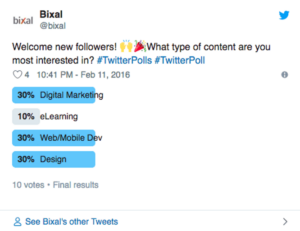
You can also invite your audience to interact with your profile by asking fun, light-hearted questions that invite them into learning more about what your company has to offer.

Contests
According to the CMI report, marketers believe that contests are the most effective type of interactive content you can use, especially in the early stage of the buyer’s journey.
Contests can include traditional raffles or giveaways. They can offer the chance to win a prize if they refer a friend to your company’s offerings. You can even introduce photos or hashtag contests where you invite your audience to submit their own user-generated content.
We have seen a rise in these types of hashtag contests and challenges across all social media platforms, especially on TikTok. The platform allows companies to leverage a hashtag to promote their brand, and users are eating it up.
Guess was the first brand in the US to release a marketing campaign as an official partner with TikTok. They ensured that every time a TikTok user opened the app, they were directed to the #InMyDenim hashtag challenge. Since its launch, videos with the hashtag have garnered over 38 million views and introduced the Guess brand to young Millenials and Generation Z.
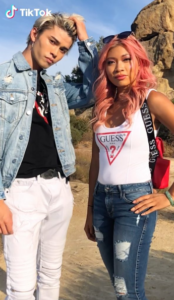
Contests are great at bringing out people’s natural curiosity and competitive spirit, so encourage them to participate by providing an engaging contest.
Interactive content that is engaging and personalized provides your audience with a new way to engage with your brand and can build trust with your audience. Learn how Bluetext can help you leverage interactive content in your content marketing plan here.
It’s no surprise that video has taken the digital ad space by storm. It’s rare that you scroll your newsfeed or surf the web without being served an ad that is relevant to your specific interests. In 2019, 87% of marketing professionals were leveraging video in their media strategies and more than 80% of video marketers saw a stronger ROI than when they ran static banner ads or paid social image ads.
So, why are video ads so popular? And why should marketers continue to invest in video advertising in 2020?
Expanded Inventory
For starters, video inventory is incredibly robust. You can reach users across a variety of different platforms and sites – from social platforms to Connected TV devices. That’s right, you can now tailor ads to reach users while they’re streaming a show through their smart TVs. Marketers can also place video pre-roll ads across premium website inventory, along with video-specific platforms like YouTube, where ads play before or during video content that a user is viewing.
Video ad inventory has expanded across social platforms in the past few years as well, and the results have been significant. Platforms such as Instagram and Facebook see 49% higher interactions on video ads than with image ads. With such impressive engagement metrics, it makes sense that marketers are investing more of their media dollars into paid social video ads. In fact, paid social video ad spend accounted for 28.7% of all video ad spending in 2019 ($10.35 billion). This number is projected to grow to $12.48 billion in 2020.
Unique Ad Formats
The unique ad formats offered through video is another reason why marketers are investing more of their paid media budget into the medium. Sprout Social reports that marketers are increasing their digital video budget by 25% year-over-year due to the increase of new ad formats. For example, marketers are now leveraging Instagram stories to connect with users for :15 seconds through an immersive experience with a full-screen interactive video. In 2019, one-third of Instagram’s most-viewed stories came from businesses, and 20% of those stories drove users to directly message businesses.
Another evolving ad format that businesses are taking advantage of is YouTube’s 6-second bumper ad. YouTube bumper ads are non-skippable, and while quite short, marketers have been able to successfully story-tell through a sequence of these 6-second ads. Google Ads shares that “many large brands are using bumper ads to drive upper-funnel goals like ad recall and awareness…. [they] are a cost-effective way to reach your target audience, ensure your message is seen and heard, and keep you top of mind.”
As mentioned previously, the ability to target users through Connected TV (CTV) devices is a huge win for marketers. There is a shift happening between traditional TV and CTV; many households are ditching cable subscriptions and switching to subscriptions with streaming services such as Hulu, Amazon Prime and Apple TV to get their news and entertainment. By 2022, it’s projected that 35 million viewers will watch TV exclusively through streaming services. The result? Marketers are investing less in traditional TV commercials, and instead, putting those dollars behind non-skippable :15, :30 and :60 second CTV ads. The best part of CTV advertising is that you actually have access to ad data! With traditional TV, networks will provide projected impressions for running commercials during specific time slots; however, with CTV, you’ll know exactly how many users watched your ad, along with viewability metrics and insights into ad recall.
The Future of Video
While banner and image ads have seemingly run their respective courses, the future of video advertising looks promising. With new formats and campaign functions rolling out across platforms specifically for video, marketers should set aside a healthy media budget for testing new video opportunities in 2020.
One new practice that Google Ads recommends is to make your video and search ads work together. Google Ads states that marketers who run search and video together will experience a 45% higher lift in ad recall, and a 180% higher message retention. One brand, in particular, found that running video alongside paid search led to a 4x increase in branded search, and dropped their CPA by 70%.
Another new trend popping up across paid social is the use of live video. Marketers are investing in live video as a means of building trust and transparency with consumers. We’re used to seeing this trend across Instagram and Facebook Stories, and video-first platforms like Snapchat. However, some businesses are migrating live video to LinkedIn to help tell brand stories and to show followers the real people behind the company name. Live video is helping to break down walls and let users connect with businesses in a personal way.
Other new video opportunities coming our way are: shoppable video ads, augmented reality campaigns, new possibilities on IGTV and Facebook Watch, and so much more.
Bottom line: Invest in video advertising in 2020. You’ll be glad you did. Find out how Bluetext has leveraged video ads in successful go-to-market campaigns.
In a world where we are flooded with advertisements and sponsored content every moment of every day, how can you make your ad stand out from the rest? What is going to make a consumer buy your product vs. your competitor’s product if they have the same features and are selling for the same price? Sure, vibrant colors, strong call-to-actions and unique imagery can help, but in order to get the right users to engage with your content and actually convert, you have to go a step – or a few steps – further. The key to marketing success in 2020 is personalization.
In many ways, marketers already know the benefits of personalized ads. For example, we know that digital retargeting ads drive more conversions and have a stronger conversion rate than prospecting ads, merely because retargeting ads are tailored to reach users who have already visited your site. Retargeting ads are more personalized than prospecting ads in nature – we know someone visited the site and expressed interest but didn’t convert, so we use that information to create a new ad with different messaging and a stronger CTA to entice that user to convert. That’s personalized marketing, in its simplest form.
In 2020, personalization is not only growing, but if you don’t take advantage of personalized marketing, your digital ad campaign might fail. Studies show that people are 80 percent more likely to buy something when a brand makes the experience personal. With access to sophisticated technologies such as AI machine learning at our fingertips, marketers are equipped with the tools necessary to tailor ads to personal attributes and behaviors, at scale.
As Martech Advisor states, “AI personalization refers to the categorization of different customer data sets and extracting valuable insights from them. These insights are fed into an automation engine that can take action without human intervention.” In other words, AI machine learning scans a user’s online behavior to understand what type of messaging would resonate best with that end-user. Have you ever visited your Amazon Prime home page to discover several new products that Amazon is recommending for you, that you’ve never seen before? This is AI-based personalization. Amazon’s AI scanned your past user and purchase behavior and introduced you to new products, customizing your home page to match your personal attributes. You’ve likely experienced something similar on music streaming apps – Spotify recommends a playlist for you based on the songs you’re listening to at that point in time.
So – how can you take advantage of personalized marketing? Here are 3 ways you can start to leverage consumer data to customize (& personalize!) your advertising:
- Dynamic Ads – Perhaps the most daunting reason why marketers don’t take advantage of personalized advertising is the assumption that ad creative and targeting processes are manual; however, AI has completely changed the game. Through AI, digital ads can now be dynamically created based on user behavior. We touched on retargeting earlier, but with AI learnings, retargeting efforts have become far more sophisticated. If a user visits a specific white paper or product on your site but does not download or buy, AI can generate an ad for that specific white paper or product and place it in front of that user with tailored messaging. Best of all? This entire process is automated. Gone are the days where your creative team is buried in producing 50 ads in 7 different ad sizes.
- Invest in AI tools for your website – Tools such as AI-powered chatbots or AI engines can shed light on how you can personalize ad campaigns. Chatbots allow users to share data that might not be readily available through other form submissions on the site. The information users provide in a chat is then scanned through AI, producing key insights for marketers to use when forming ad campaigns. For example, if the same pain points or topics continue to surface through chatbots, you might have an idea for your next personalized go-to-market campaign.
- Tailor your campaigns based on audience segments – This sounds simple enough, but more times than not, marketers target all audiences segments under one campaign, rather than breaking up campaigns based on audience segments. For example, you want to target users who play basketball, soccer, football and tennis. You place all of these audience segments under one campaign and serve the same ad and ad copy to each user. Sure, these are similar audience segments in that they are all sports-related; however, a user who plays basketball will likely ‘look’ different than a user who plays tennis. Instead of serving the same ad and ad copy to all users, why not tailor your messaging to each specific audience segment? The more personalized you can get the ad and ad copy level, the more likely your ad will resonate with the end-user and lead to a conversion. Of course, a campaign structure like this that used to be manual has become nearly automated through DSPs and Paid Social platforms that provide ways to streamline this process, freeing up your time and eliminating human error.
In 2020, we challenge marketers to take a step back from the generic go-to-market campaigns and to get personal! How will you use AI-based personalization and machine learning to enhance your digital ad campaigns? Learn how Bluetext has used personalized marketing for our clients’ campaigns, effectively reaching the right audience with tailored, custom creative, via our website.
Programmatic Advertising – No Signs of Slowing Down in 2020
If you spend any time at all surfing the web, you have encountered some form of programmatic advertising. The video ad that plays before you stream your favorite TV show? Programmatic. The banner ad that appears alongside the cooking recipe you’re reading? Programmatic. The sponsored article content that shows up as you’re scanning your favorite news site? You guessed it – it’s programmatic.
Programmatic Advertising – What is it?
Programmatic ad buying is the use of software to purchase digital advertising in real-time, as opposed to the traditional ad buying process that involves RFPs, human negotiations, and manual insertion orders. It allows digital agencies like Bluetext to strategically select where we want to show display, video and native ads, and when.
A huge benefit of programmatic advertising is that the software grants advertisers access to the biggest data providers in the game. Not only are we choosing where and when to show ads online, but we have the capabilities to choose who actually sees our ads. Advertisers are able to hand-select from thousands of audience segments collected by these data providers and layer those segments onto programmatic campaigns.

Why Invest in Programmatic?
While targeting capabilities and ease-of-use are two major benefits of investing in programmatic advertising, there are a number of reasons why digital agencies should hop on the programmatic bandwagon in 2020.
Here are Bluetext’s top 3 reasons for investing in programmatic advertising in 2020:
1. Artificial Intelligence (AI) and Machine Learning
Programmatic advertising already makes digital ad buying easier for advertisers than it ever was before, but AI and machine learning have simplified the process even more. For years, media buyers and digital marketers relied on a manual process to review campaigns, manage budgets, make adjustments to ad creative, and more. However, AI and machine learning have become so sophisticated that the manual days of optimizing are nearly over. Once your campaign has launched, the AI will start to learn what’s working and what’s not, shifting budgets and making adjustments to enhance efficiency in real-time. Studies show that by 2035, AI will boost productivity and profitability by nearly 40%.
As a leading digital marketing agency, Bluetext has seen the benefits of AI and machine learning pay off in major ways. Not only is our digital marketing team more efficient, but the results we were able to drive for clients in 2019 far exceeded their goals. With AI and machine learning only becoming smarter, Bluetext is equipped to reach new heights with programmatic advertising in 2020.
2. Digital Out of Home (DOOH) Opportunities
Digital Out of Home (DOOH) advertising is a unique marketing channel that allows advertisers to reach users outside of their homes in digitally-displayed spaces. Though DOOH media isn’t new, it’s expected to grow exponentially in the coming years. Reports show that between 2016 and 2023, the DOOH media channel will grow from $3.6 Billion to $8.4 Billion.
With the average person spending 70% of their time outside of their home, investing in DOOH in 2020 is a no-brainer. From mobile geofencing to digital billboards, the opportunities to reach people on-the-go are vast. Most importantly, because DOOH is now offered through programmatic platforms, advertisers will have access to significantly more data from DOOH advertising than ever before.
Digital marketing agencies like Bluetext now have the ability to measure results from a digital billboard ad or an animated kiosk through the data and technology programmatic tools provide. Bluetext is looking forward to expanding DOOH capabilities in 2020 to connect the dots from in-home browsing to in-store purchasing.
3. Multi-Channel Advertising
In the past, advertising agencies had to leverage several different platforms, media vendors and direct buys to ensure they reached their audiences across all mediums. Programmatic advertising has simplified this process so that marketing agencies like Bluetext can execute all advertising efforts through one simple-to-use platform.
Programmatic solutions include paid social, display, video pre-roll, native advertising, geofencing, DOOH, connected TV and more. Digital marketing agencies like Bluetext now have the capability to run one digital campaign across all different mediums and – most importantly – track user behavior across all touchpoints. With AI and machine learning, programmatic campaigns will optimize to reach users at the right time on the right medium, whether that’s on the computer, on their smart TV, or in a store on their mobile device. In 2020, it’s expected that even more multi-channel solutions will be announced, such as voice-activated ads powered through devices like Alexa and Siri.

Programmatic advertising has opened the door for digital marketing agencies like Bluetext to effectively run and execute campaigns across a number of channels and mediums, making media dollars more efficient than ever before. With the expansion of programmatic solutions in 2020, there’s no limit to the number of possibilities Bluetext will be able to leverage to drive digital media success for our clients. To learn more about our work with programmatic advertising contact us.
Content marketing is a consistently invaluable tool to increase conversions by educating your leads and customers. As we welcome a new year as well as a new decade, it’s important to understand the emerging content marketing trends that will dominate 2020. How should you change your digital content marketing strategy to keep pace with the ever-evolving nature of content marketing?
In this blog post, we take a look at 5 content marketing trends that will keep you ahead of the curve in 2020 and beyond.
Data-Driven Content
How are you, as a brand, determining what content is useful and relevant for your audience? That’s where data comes in. By harnessing the lessons of previously successful content marketing initiatives, companies are able to reverse engineer the data and identify KPIs that preceded the success. Once those KPI’s have been established, it is easier to create content in that same strain and capitalize on the proven success. A DC-based digital branding agency like Bluetext can assist you in determining successful KPI’s and creating the rich content your audience wants to read.
Smart Device-Centric Content
Although smart devices have been a key consideration in B2C content marketing for quite some time, this year, more focus will be placed on specific functions of smart devices such as voice search. Voice search is becoming such an integral mobile tool, 48% of consumers are using voice for “general web searches.” Companies looking to stay ahead of the curve should look to optimize their content specifically for voice search purposes. Understanding how users search via their voice will help you tailor your existing content for voice-SEO and create more effective headlines for future content initiatives. A DC digital web design agency like Bluetext can help by conducting an analysis of your audience’s voice searches and recommend changes to your existing content and future content to maximize the return on your investment.
Conversational Marketing is King
In the digital era which champions online shopping, consumers are looking to establish trust and connection through more personalized, authentic shopping experiences. Conversational marketing can aid your company in engaging with your audience in a more genuine way. By engaging in a conversation, your company gains access to more personalized data about your consumers such as their specific needs and future goals. Investing in tools such as chatbots or real human-to-human experiences can make all the difference in your competitive industry. As we progress through 2020, chatbots and other AI tools will continue to improve and positively impact lead generation.
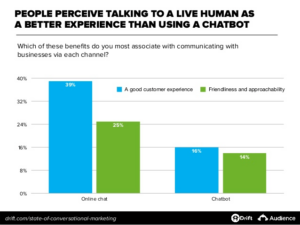
2020: The Year of the Snippet
As we know, Google dominates the search engine market share worldwide, with a resounding 92.71% of the market. When considering a user’s search intent, Google will display what they call a “snippet” at the top of the page, which provides consumers with key points within a piece of content, allowing them to receive the information they’re looking for faster. As such, it’s becoming more commonplace for consumers to enter a longtail keyword into Google, knowing that they will receive the information they’re looking for via a snippet, without clicking any page links whatsoever.
In order to win that highly coveted snippet spot, companies should look to hire an interactive web agency such as Bluetext. Bluetext’s SEO analysts can conduct an audit of your current content and pinpoint exactly where changes need to be made in order to signify to Google crawlers that your content is important. Optimizing your content for snippets will greatly enhance user experience, as users will be able to find the information they are searching for concisely and quickly. Not only will an interactive web agency audit and enhance current site content, but they will also create a content strategy and editorial calendar so your brand can continually publish content your users are searching for.
The Popularity of Podcasts
According to a recent study, 51% of the entire US population has listened to a podcast in 2019. That figure is up by 7% from the previous year. As we look ahead to 2020, podcasts will continue to dominate, as that number is expected to keep rising. Although it may seem like everyone has a podcast these days, there are still opportunities for brands to get ahead of the curve and start their own podcasts.
That being said, if you see a clear demand for audio content within your market, ensure that you create a podcast the right way. Podcasts should have clearly defined KPI’s, a regular posting schedule, and content your audience will actually care to listen to. A Virginia internet & inbound marketing agency like Bluetext can partner with your company to assess the need for a podcast in your industry and among your competitors, help you create valuable content and even develop a paid advertisement plan to spread awareness via other podcasts your audience is listening to.
2020 is already well underway and in order to achieve success, companies need to get ahead of this year’s trends with a thorough and achievable marketing strategy and plan of action. A DC digital branding agency such as Bluetext can audit your current digital content marketing strategy and suggest recommendations to help improve your current trajectory. To learn more about Bluetext and how we can help you, check out our work here.
With the start of the new decade, the digital marketing industry is abuzz with anticipation for 2020. Top interactive agencies are predicting big shifts in the upcoming year, in everything from engagement tactics to design and user experience. Bluetext, as one of Washington DC’s leading digital marketing agencies, has some 2020 predictions of our own.
In the upcoming year, trends in technology will alter and enhance how the world interacts with various media. Top interactive agencies are predicting massive growth in virtual reality digital marketing. The future will be filled with smart devices delivering increasingly insightful and interactive digital experiences. Recent innovations have allowed marketers to blend digital and physical realms to create an immersive world. Technology will enable expanded connections between sets of people, businesses, devices, content and services.
A top technology trend of 2020 will be virtual reality (VR) and augmented reality (AR). Virtual reality refers to any type of experience that places the user “in” another world or dimension. Augmented reality is a term for essentially placing virtual content “into” the real world by way of, for instance, your camera on your iPhone or an app. The most popular example of this is Pokémon Go.

Top interactive agencies have been demonstrating the power of VR to change how users perceive the world and creating a truly immersive experience. Virtual reality production companies are expecting the next generation of VR to be able to sense shapes and track a user’s position and mixed reality (augmented and virtual) will enable consumers to view and interact with the world.
Virtual and augmented reality have been around for years, however, many companies were hesitant to adopt due to a poor user experience. Through recent tech improvements and growing expertise of user experience & interface companies, such as Bluetext, AR and VR are expected to grow quickly. In the next two years, Gartner predicts “70% of enterprises will be experimenting with immersive technologies for consumer and enterprise use.” Google cardboard glasses are a popular —and inexpensive—method to distribute the virtual reality digital marketing experience. 
A number of companies have already deployed innovative AR and VR experiences, especially in the B2C realm. Companies such as Sephora and IKEA are using augmented reality to allow consumers to preview and test products. While AR and VR lend well to the “try before you buy” sales strategy with enticing previews to persuade a final purchase decision, it has also been used in campaigns to turn heads. Burger King unveiled an AR experience that quite literally burned away the competitor. The fast-food chain encouraged app users to scan competitors’ ads, which would activate an augmented reality experience. As the competitor’s ad combusted, it was replaced with a Burger King ad and directed to the nearest restaurant to claim a free Whopper.
Top virtual reality digital marketing experts will tell you this tech trend is sweeping a variety of industries as a method of differentiation. Especially in the B2B market, virtual reality has proven to be an incredibly powerful marketing tool to help close a sale and drive conversion. A virtual reality experience can go in-depth to product specs and prove exactly why it’s superior. When designed by a top virtual reality video production company the experience can be like a trade show, a sales demo, and a marketing presentation in one. Industries like cybersecurity or manufacturing can truly benefit from immersive experiences. When products are shown through virtual reality, the viewer can demo a complex product with ease. Top virtual reality video production companies also stress the importance of standing out in saturated markets and hectic trade shows.

An effective and memorable AR or VR experience is an opportunity to capture physical attention and convert that to digital action. Interested in differentiating your company with next-generation digital tactics? Learn how Bluetext can bring your video and virtual reality ideas to life.
2019 has been a big year for Bluetext full of limitless growth and many successful launches. As one of the top digital marketing agencies in the Washington, D.C. area, we are growing faster than ever in both size and knowledge.
As we look back on 2019, we can reflect on some of our major accomplishments. Partnering with impressive and innovative clientele gives our team the opportunity to push our creative boundaries and exceed client expectations.
This past year, ResMan, a property management platform with a robust range of solutions, sought out Bluetext as a top marketing firm for their digital needs. With the introduction of a new suite of offerings and a more holistic platform, ResMan needed to repackage their solutions and relaunch their digital presence. ResMan brought in Bluetext to reinvigorate the ResMan brand with an updated website and CVI, while modernizing and streamlining their existing brand.
Bluetext took inspiration from Resman’s customer-centric philosophy and delivered on a request for external messaging and marketing efforts to reflect their goals as a company. Bluetext stepped up to the challenge and seized this project as an opportunity to enhance expertise as a top user experience agency. Resman’s request was met by a fully redesigned—and responsive—website, focusing on an enhanced UX that guides users with an intuitive website flow.
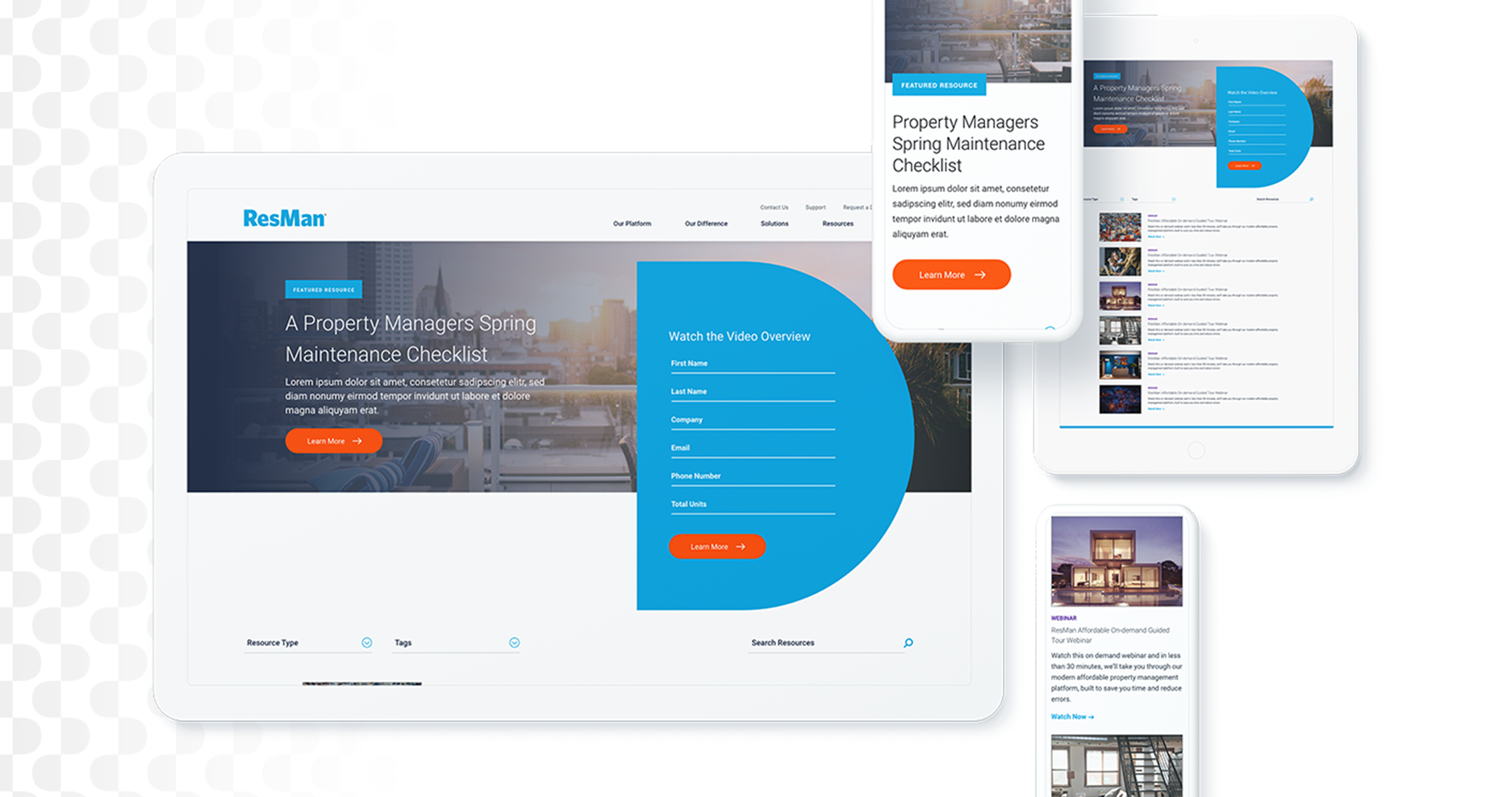
Similarly, Bluetext assisted in creating the new Mindtree.com, which offers an intuitive, fully responsive user experiences and personalization to serve relevant content to each user. As a leading global digital transformation and technology services provider, MindTree needed a brand and website that reflected their capabilities and future-focused customers. The website utilized Drupal 8 CMS platform to provide the utmost flexibility and scalability needed by such a large enterprise while allowing a design that reflects a vibrant brand and its employees. This improved user experience translated to measurable results, as the bounce rate decreased by 20% and website traffic rose 60% post-launch.

What does MindTree have to say about the experience? “Bluetext has been a tremendous digital agency partner to the Global Marketing Team at Mindtree. From digital brand strategy, to innovative user experience design, to enterprise Drupal content management implementation expertise… they were impressive every step of the way. Great collaborators with our in-house folks – I would strongly recommend the amazing team at Bluetext!”
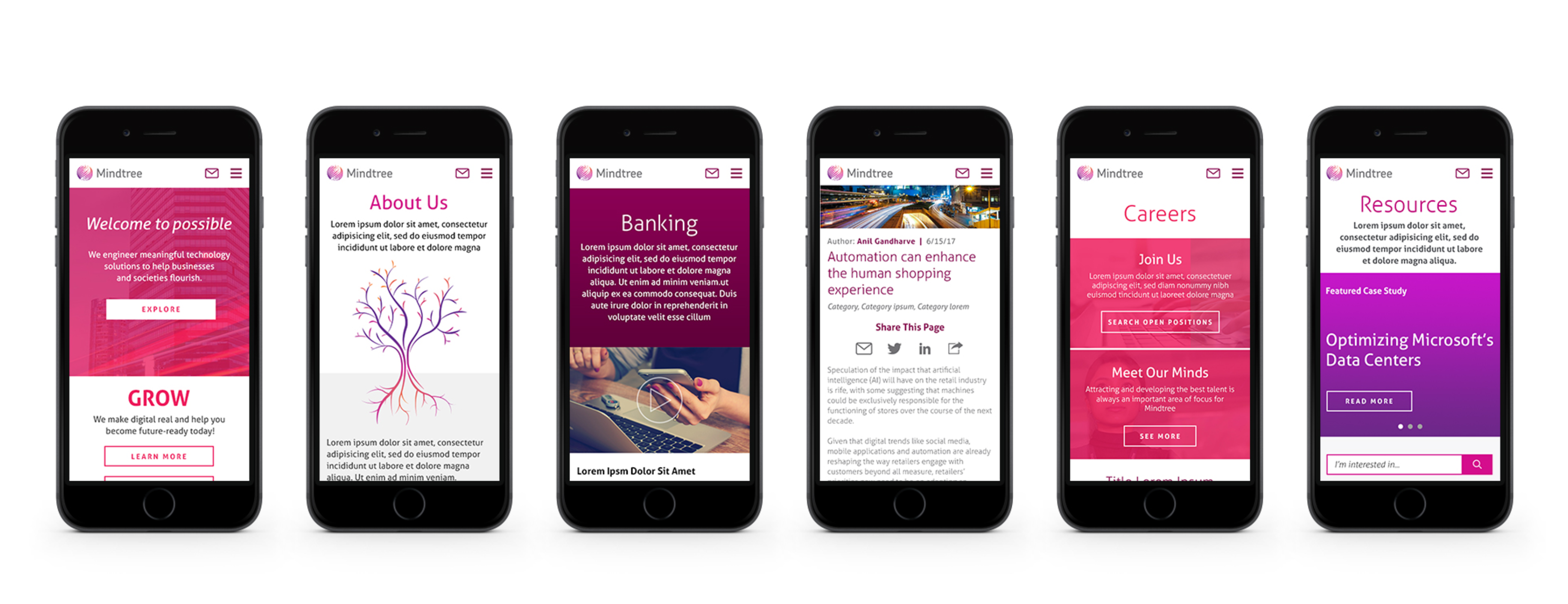
Bluetext takes pride in offering exceptional client service and taking the time to learn a client’s distinct brand values and user needs. Bluetext has succeeded in bringing our client’s values to life through digital marketing and campaign deliverables. A portfolio of industry-leading clients has taught us to treat every new project as a two-sided relationship to grow and enhance both parties’ business value. Our efforts to work backward, prioritizing the end-user experience and ultimate brand goals have translated into the measurable success that we look forward to continuing into 2020.
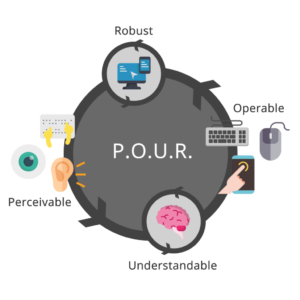 Meeting Accessibility Standards Begins with Design
Meeting Accessibility Standards Begins with Design